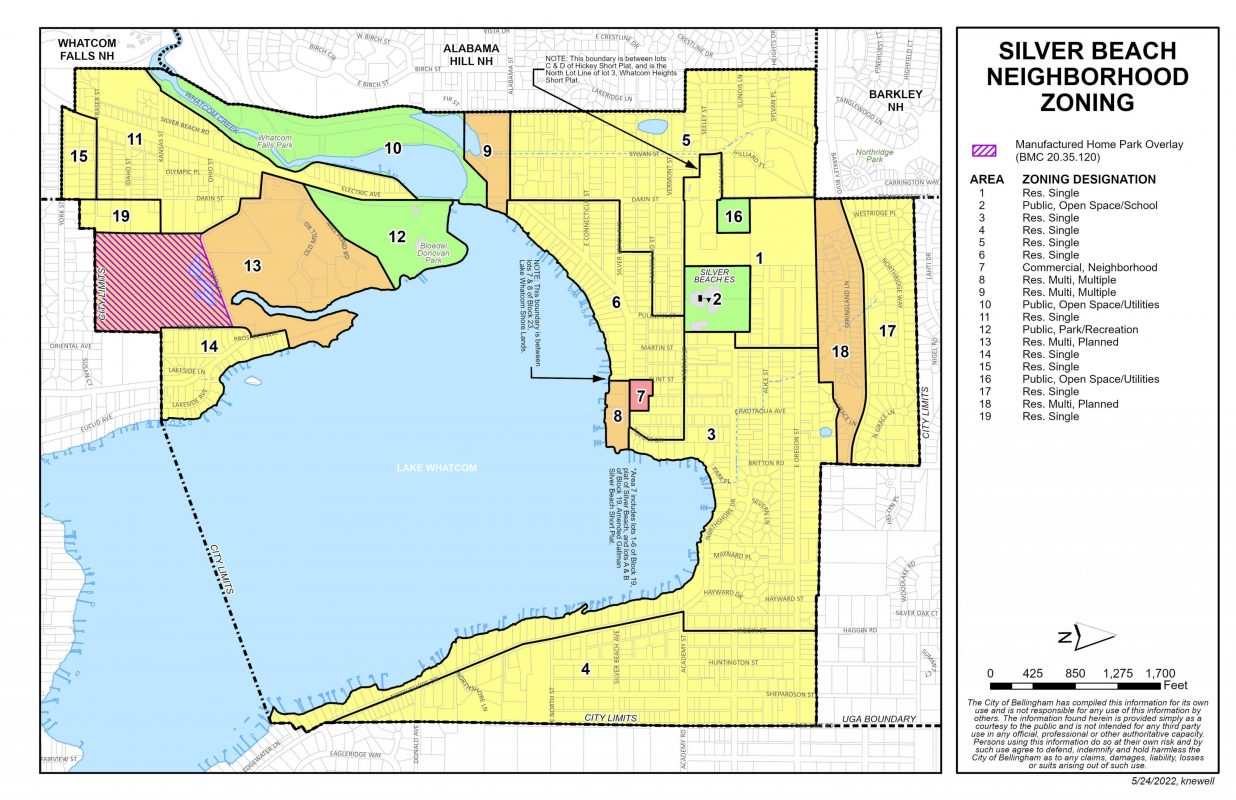last updated 06/18/2024
Overview
Bellingham City Council held a public hearing on Monday, May 20, 2024. At the end of the hearing, City Council approved recommended changes to stormwater regulations in BMC 16.80 (recommended changes are described below).
In addition, a work session was held on June 3, 2024, to consider proposed changes to densities in the Silver Beach Neighborhood (recommendations described below). At the end of that session, City Council approved a low-density option for all of the multi-family areas in that neighborhood. As part of the approval, City Council added a provision that allows property owners exceed low-density and move up to the medium density maximum if they get approval of development agreements. The development agreements must include measures to enhance the water quality of Lake Whatcom.
Both sets of changes will take effect in early July.

Recommended Changes
Density Recommendations
City staff proposes amendments to the Silver Beach Neighborhood zoning table (BMC 20.00.170) that would reduce the density ranges in three of the four multi-family zones from “high” to “medium” (in areas 8, 9 and 13). This essentially constitutes a rezone of these areas and is considered a “comprehensive plan amendment and rezone.” Staff is not recommending a change to density in area 18 which already has a medium density zoning designation and is fully built out with single family residences.
Recommendations to Revise Stormwater Management Requirements (Water Quality Protections)
City staff is also proposing amendments to the Lake Whatcom Reservoir Regulatory Chapter (BMC 16.80) to establish specific rules for development of new units and redevelopment of existing multi-family units in areas 8, 9 and 13. The intent of the proposed amendments is to protect water quality in Lake Whatcom.
Currently, the regulation of impervious surfaces that are associated with development of multi-family units is addressed on a case-by-case basis using the State Environmental Policy Act (SEPA). The proposed amendments would require multi-family development and redevelopment to be at least as protective as those rules for development and redevelopment of single-family units within the watershed.
The proposed amendments would require existing and new multi-family sites that add or replace more than 300 square feet of impervious surfaces to bring the entire site into full compliance with phosphorous reduction requirements, which means that:
- New stormwater management treatment facilities that reduce phosphorus would be required to be installed.
- A minimum of 30 percent of the subject property would have to be converted to a Pacific Northwest lowland forest.
Other minor, clarifying, non-substantive revisions to BMC 16.80 and BMC 20 would be necessary to facilitate the proposed amendments.
Actions to Date
- The Planning Commission held a public hearing on the proposed changes on March 21, 2024.
- The Planning Commission held a follow up work session on April 11 at 7 p.m. in the City Council chambers.
- See the Materials prepared by City Staff for the April 11 Planning Commission Work Session regarding the Silver Beach Rezone and Amendments to BMC 16.80.
- At the conclusion of the work session, the Planning Commission, by a vote of 6-0 (one member absent) made a recommendation to adopt the proposed amendments to BMC 16.80 pertaining to stormwater treatment requirements.
- In addition, by a failed vote of 3-3 (one member absent), the Planning Commission was unable to make a recommendation on the medium density proposed by City Staff. While there is not a recommendation from the Planning Commission, Staff will still recommend medium density at the City Council public hearing on May 20.
- On May 20, 2024, Bellingham City Council unanimously approved the stormwater management requirements. You can view the material that was discussed at the May 20 meeting here.
- During that same meeting, City Council also voted to revisit the proposed density rezone on June 3.
- At a future, undetermined date, they requested staff to present additional actions the City could take to improve stormwater management on private properties in the Bellingham portion of the Lake Whatcom watershed.
- A work session was held on June 3, 2024, regarding the rezone recommendations. Only materials previously provided were considered at the session.
